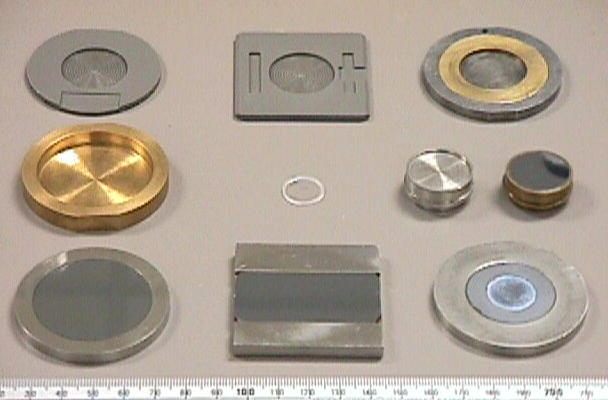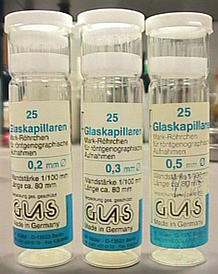 |
Sample Holders |
 |
Sample Holders |
Reflection Geometry
The photograph below shows a variety of sample holders for the flat-plate Bragg-Brentano geometry described earlier. All of the large sample holders are for room-temperature work, while the three smaller sample holders are for high-temperature furnace use. Click on the sample holders for more information on their usage.

Flat plate sample holders have one very big advantage over other sample holders: they are easy to fill. Their biggest disadvantage is that the flattening process induces preferred orientation at the surface in many samples. This is discussed in more detail in later pages.
 There are two basic methods of measuring a sample in transmission geometry:
the X-rays can be transmitted through either a cylindrical or a flat plate
sample. The most common cylindrical sample holders are the
glass capillaries illustrated left which come in a variety of sizes: 0.2, 0.3,
0.5, 0.7, and 1.0 mm are common diameter values, though the larger
diameters are less useful for most powder work due to sample absorption
and decreased resolution.
A practical alternative for high-temperature work is the use of
quartz glass capillaries.
There are two basic methods of measuring a sample in transmission geometry:
the X-rays can be transmitted through either a cylindrical or a flat plate
sample. The most common cylindrical sample holders are the
glass capillaries illustrated left which come in a variety of sizes: 0.2, 0.3,
0.5, 0.7, and 1.0 mm are common diameter values, though the larger
diameters are less useful for most powder work due to sample absorption
and decreased resolution.
A practical alternative for high-temperature work is the use of
quartz glass capillaries.
Capillaries are unpopular for several reasons: Firstly, incoherent X-ray scattering from the glass walls, which are approximately 0.01 µm thick, adds significantly to the background count. Secondly, they take considerably longer to fill than the equivalent flat-plate sample holder. One practical solution is to vibrate the end of the capillary against the bottom wall of an ultrasonic bath (usually filled with water). Note that this only works if any lumps in the powder have first been removed by sieving the sample. Thirdly, the capillaries require careful alignment on the diffractometer. For those not familiar with capillary alignment, see the procedure given. Fourthly, for highly-absorbing samples either fine capillaries have to be used or the sample has to be diluted. Further still, an absorption correction may be required when the data are used for crystal structure refinement.
After all these disadvantages, you might wonder why capillaries are used at all. The main advantage of the capillary is that preferred orientation is far less of a problem although it can still occur when needle-shaped crystallites align with horizontally-rotated capillaries. Capillaries are also a convenient way of mounting very air sensitive samples since they are easily sealed against exposure to the air.
An alternative to the capillary is the use of a thin glass fibre, thinly coated in silicone grease and the covered by a fine coating of powder. This can sometimes be better for highly absorbing samples.
An alternative method for measuring powder samples in transmission geometry is to use a very thin and flat sample. This can be achieved by sprinkling the powder on to a very thin sticky tape, or by trapping the sample between two layers of a thin (say 3 µm or thinner) plastic film. Various plastics including Mylar have been used, some of which are better than others: the choice of plastic is a compromise between obtaining a very low background count and a peak free background count.
It is sometimes argued that the transmission method uses less sample than the reflection method, but this is not necessarily true since tiny amounts of a fine powders can be measured using the silicon sample holders shown above.
| © Copyright 1997-2006. Birkbeck College, University of London. | Author(s): Jeremy Karl Cockcroft |